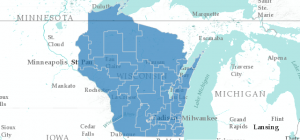
(Wisconsin Legislative Technology Services Bureau)
The Supreme Court hears oral arguments today in a case that could reshape how legislative districts are drawn in the United States. Every ten years, when the U.S. does a census, political maps across the country are redrawn by state legislatures. This gives the political party in control of the state legislature enormous power because they are the ones who get to decide how these new districts will be drawn. Now, the Supreme Court has ruled that you can’t draw districts based on racial lines (something they reenforced two times last term). But making districts that benefit one party over the other by diluting the impact of the minority party’s vote? That’s been totally legal.
Today the Supreme Court will hear a challenged to the way Wisconsin drew its legislative map in a case called Gill v. Whitford. Following the last census in 2010, the Republican-controlled Wisconsin legislature redrew their districts map is such a way that, in 2012, Republicans carried less than half of the overall vote (48.6 %) but won nearly two thirds of the seats in the state assembly. The Supreme Court is set to decide whether maps like Wisconsin’s are unconstitutional.
Learn more about the history of racially-based gerrymandering in our film One Person, One Vote.

